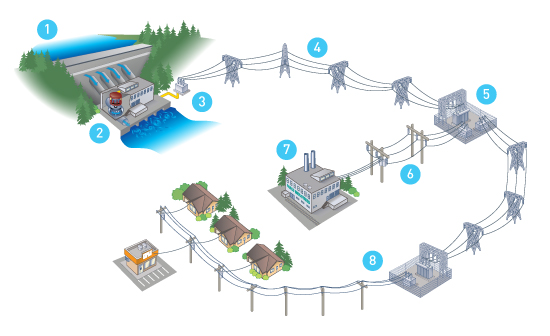Hydro electric generation system
How power is generated
BC Hydro generates power by harnessing the power of moving or falling water to produce mechanical/electrical energy. BC Hydro generates over 43,000 gigawatt hours of electricity annually to supply more than 1.6 million residential, commercial and industrial customers. This power is delivered using an interconnected system of over 73,000 kilometres of transmission and distribution lines.
So how do we generate this power? The process begins before electricity even reaches customers. The steps to generating electricity from a dam and how it is transported are outlined below.

1. Hydroelectric dam
There is potential energy stored in a water reservoir behind a dam. It is converted to kinetic energy when the water starts flowing down the penstock, from the dam. This kinetic energy is used to turn a turbine.
2. Generator
The falling water strikes a series of blades attached around a shaft which converts kinetic energy to mechanical energy, and causes the turbine to rotate. The shaft is attached to a generator, so that when the turbine turns, the generator is driven. The generator converts the turbine's mechanical energy into electric energy.
3. Step-up transformer
Voltage is the pressure that makes electricity flow. Generators usually produce electricity with a low voltage. In order for the transmission lines to carry the electricity efficiently over long distances, the low generator voltage is increased to a higher transmission voltage by a step-up transformer.
4. Grid high voltage transmission lines
Grid transmission lines, usually supported by tall metal towers, carry high voltage electricity over long distances.
5. Terminal Station
Terminal stations control power flow on grid transmission lines and reduce the grid voltage to subtransmission voltage.
6. Subtransmission lines
Subtransmission lines supply power from terminal stations to large industrial customers or distribution substations.
7. How it is used by the customer
Electric energy can be sold at transmission voltage to users of large amounts who own and operate their own substations. Most customers, however, are unable to accept energy at transmission voltage, and require that it be stepped down in a transformer.
8. Distribution substation
A distribution substation is a system of transformers, meters, and control and protective devices. At a substation, transmission voltage is reduced to lower voltages for distribution to residential, commercial, and small and medium industrial customers.